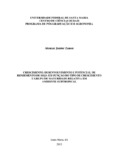| dc.creator | Zanon, Alencar Junior | |
| dc.date.accessioned | 2017-04-25 | |
| dc.date.available | 2017-04-25 | |
| dc.date.issued | 2015-12-21 | |
| dc.identifier.citation | ZANON, Alencar Junior. Growth, development and soybean yield potential as a function of growing type and maturity group in subtropical environment. 2015. 179 f. Tese (Doutorado em Agronomia) - Universidade Federal de Santa Maria, Santa Maria, 2015. | por |
| dc.identifier.uri | http://repositorio.ufsm.br/handle/1/3257 | |
| dc.description.abstract | The objectives of this thesis were: To estimate the relative maturity group of old and modern soybean cultivars used in Southern Brazil; To quantify the branches contribution in the leaf area index; To characterize the development and the overlap period of vegetative and reproductive phases, growth in height and the emission of nodes after the beginning of flowering in determinate and indeterminate plant type cultivars in different sowing dates and soybean regions in Rio Grande do Sul and; To identify key biophysical and management factors governing variation in soybean yield potential in Southern Brazil. Were conducted 47 experiments using 23 soybean cultivars in five growing seasons (2010/2011, 2011/2012, 2012/2013, 2013/2014 and 2014/2015) at 12 sites in Rio Grande do Sul. The relative maturity group these cultivars that had not yet been classified ranged from 4.8 to 7.3. Most cultivars showed a reduction on total leaf area index, maximum, of main stem and of branches, in the duration of the reproductive phase, of the total development cycle with delay on sowing date regardless of the maturity group and type of growth. The indeterminate type cultivars had a higher overlap period of vegetative and reproductive phases, growing in height and emission nodes after the beginning of flowering bigger than determinate type cultivars. The potential yield ranged from 2.8 up to 6.0 Mg ha-1, depending on the amount and distribution of water during the growing season and the photothermal coefficient during reproductive stages of the soybean. | eng |
| dc.description.sponsorship | Coordenação de Aperfeiçoamento de Pessoal de Nível Superior | |
| dc.format | application/pdf | por |
| dc.language | por | por |
| dc.publisher | Universidade Federal de Santa Maria | por |
| dc.rights | Acesso Aberto | por |
| dc.subject | Glycine max | por |
| dc.subject | Grupo de maturidade relativa | por |
| dc.subject | Ciclo de desenvolvimento | por |
| dc.subject | Data de semeadura | por |
| dc.subject | Tipo de crescimento | por |
| dc.subject | Fenologia | por |
| dc.subject | Coeficiente fototérmico | por |
| dc.subject | Glycine max | eng |
| dc.subject | Relative maturity group | eng |
| dc.subject | Developmental cycle | eng |
| dc.subject | Sowing date | eng |
| dc.subject | Growth habit | eng |
| dc.subject | Phenology | eng |
| dc.subject | Photo-thermal quotient | eng |
| dc.title | Crescimento, desenvolvimento e potencial de rendimento de soja em função do tipo de crescimento e grupo de maturidade relativa em ambiente subtropical | por |
| dc.title.alternative | Growth, development and soybean yield potential as a function of growing type and maturity group in subtropical environment | eng |
| dc.type | Tese | por |
| dc.description.resumo | Os objetivos desta tese foram: Estimar o grupo de maturidade relativa de cultivares antigas e modernas de soja; Quantificar a contribuição das ramificações no índice de área foliar; Caracterizar o desenvolvimento e a duração do período de sobreposição das fases vegetativa e reprodutiva, o crescimento em estatura e a emissão de nós após o início do florescimento em cultivares modernas de soja com diferentes grupos de maturidade relativa, tipos de crescimento, semeadas em épocas e regiões produtoras de soja no Rio Grande do Sul e; Identificar as variáveis meteorológicas e de manejo que governam o potencial de rendimento em soja no sul do Brasil. Foram conduzidos 47 experimentos utilizando 23 cultivares de soja, durante cinco estações de crescimento (2010/2011, 2011/2012, 2012/2013, 2013/2014 e 2014/2015) em 12 locais no Rio Grande do Sul. O grupo de maturidade relativa das cultivares que ainda não tinham sido classificadas variou de 4.8 a 7.3. Há redução dos valores de índice de área foliar máximo, da haste principal e das ramificações, da duração da fase reprodutiva e do ciclo total de desenvolvimento, com o atraso da época de semeadura, independentemente do grupo de maturidade relativa e tipo de crescimento. As cultivares com tipo de crescimento indeterminado apresentam maior período de sobreposição das fases vegetativa e reprodutiva, crescimento em estatura e emissão de nós após o início do florescimento do que as cultivares determinadas. O potencial rendimento de soja variou de 2,8 até 6,0 Mg ha-1, dependendo da quantidade e distribuição da água durante a estação de crescimento e do coeficiente fototérmico durante os estágios reprodutivos da soja. | por |
| dc.contributor.advisor1 | Streck, Nereu Augusto | |
| dc.contributor.advisor1Lattes | http://buscatextual.cnpq.br/buscatextual/visualizacv.do?id=K4721150P1 | por |
| dc.contributor.referee1 | Strieder, Mércio Luiz | |
| dc.contributor.referee1Lattes | http://lattes.cnpq.br/3765201730658979 | por |
| dc.contributor.referee2 | Bredemeier, Christian | |
| dc.contributor.referee2Lattes | http://lattes.cnpq.br/0364795290228832 | por |
| dc.contributor.referee3 | Guedes, Jerson Vanderlei Carús | |
| dc.contributor.referee3Lattes | http://buscatextual.cnpq.br/buscatextual/visualizacv.do?id=K4799031H3 | por |
| dc.contributor.referee4 | Marchezan, Enio | |
| dc.contributor.referee4Lattes | http://buscatextual.cnpq.br/buscatextual/visualizacv.do?id=K4793251A2 | por |
| dc.creator.Lattes | http://lattes.cnpq.br/7337698178327854 | por |
| dc.publisher.country | BR | por |
| dc.publisher.department | Agronomia | por |
| dc.publisher.initials | UFSM | por |
| dc.publisher.program | Programa de Pós-Graduação em Agronomia | por |
| dc.subject.cnpq | CNPQ::CIENCIAS AGRARIAS::AGRONOMIA | por |


